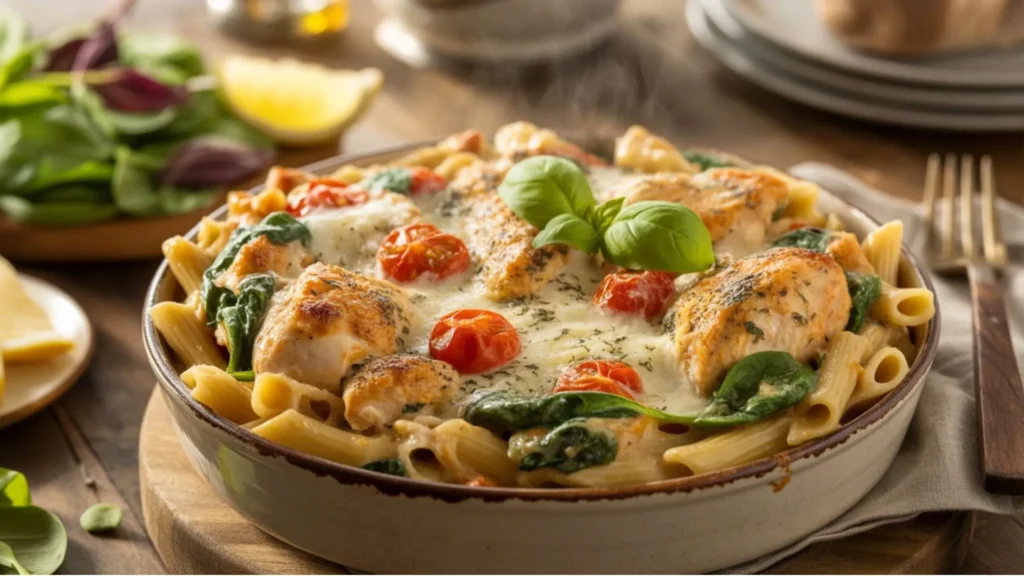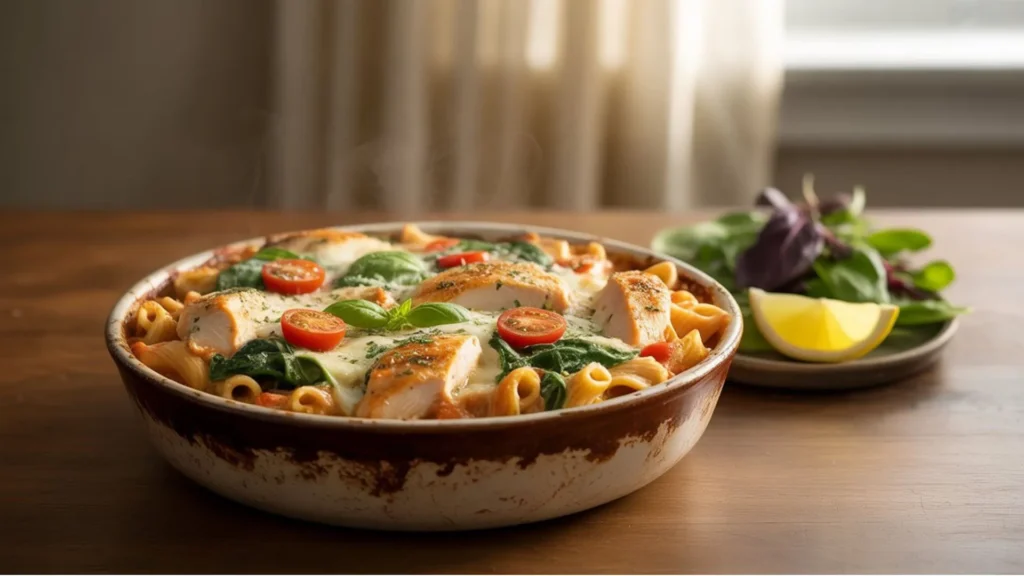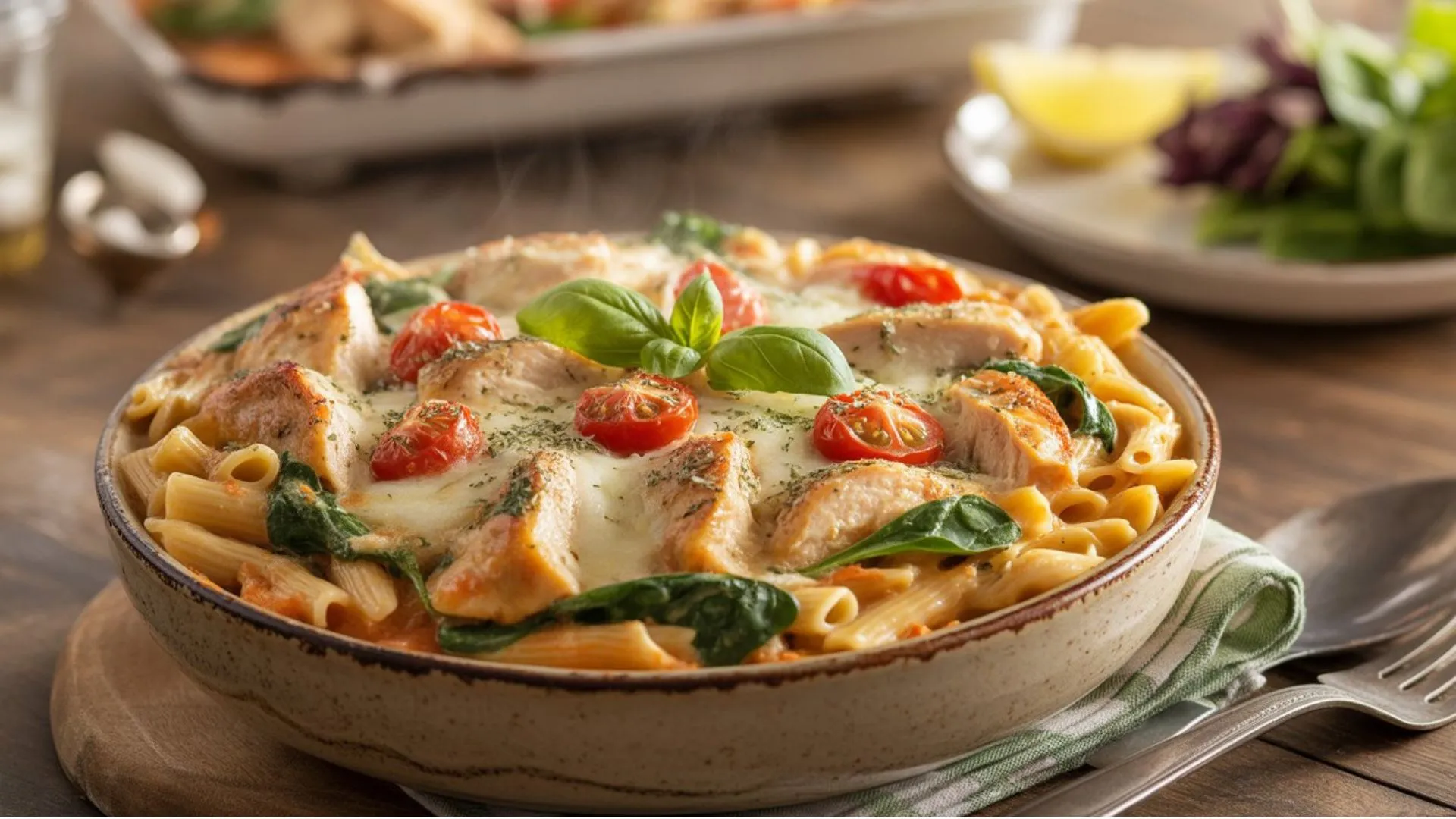Table of Contents
Healthy Chicken Pasta Bake
Picture this scenario: you walk through your front door at 6 PM, exhausted from a demanding day, and hear those familiar words echoing from the kitchen – “what’s for dinner tonight?” Your mind immediately craves something warm, comforting, and satisfying, yet you remember your commitment to healthier eating habits this year. This internal battle between comfort and nutrition happens in countless households every evening.
If you’ve ever found yourself staring into your pantry, weighing the choice between regular pasta and those veggie-packed alternatives, questioning whether healthy meals can truly satisfy your comfort food cravings, you’re experiencing what millions face weekly. Here’s the remarkable truth: you don’t need to sacrifice flavor for nutrition. This approach to healthy chicken pasta bake demonstrates that comfort food can nourish your body while delighting your taste buds.
Why Traditional Pasta Bakes Leave You Feeling Sluggish
Traditional pasta bake recipes typically overwhelm your system with excessive ingredients that contribute to that uncomfortable “food coma” feeling. Most conventional recipes pack in 2-3 cups of cheese per dish, rely heavily on processed meats loaded with sodium, use nutritionally empty white pasta, and drown everything in heavy cream-based sauces.
While indulgent dishes like creamy chicken pasta recipes can be absolutely delicious for special occasions, regularly consuming these calorie-dense meals can leave you feeling sluggish and unsatisfied despite enormous portion sizes.
Research shows that standard pasta bakes contain between 800-1200 calories per serving, with refined carbohydrates and saturated fats making up the majority of those calories. These ingredients cause rapid blood sugar spikes followed by energy crashes, leaving you feeling lethargic and unsatisfied despite consuming enormous amounts of food.
The psychological impact extends beyond physical discomfort. When you consume meals that leave you feeling overly full yet nutritionally unsatisfied, your body continues sending hunger signals, leading to late-night snacking and disrupted eating patterns throughout the following day.
Understanding How Light Foods Can Keep You Full
The Science Behind Lasting Satisfaction
Your body relies on specific signals to determine when you’ve eaten enough food. Protein triggers the release of satiety hormones like CCK and GLP-1, which communicate fullness to your brain more effectively than simple carbohydrates or fats alone. Meanwhile, fiber creates physical stomach distension and slows digestion, extending that satisfied feeling for hours.
Volume eating principles work by incorporating low-calorie, high-volume ingredients that physically fill your stomach without adding excessive calories. This approach allows you to enjoy generous portions while maintaining your health goals.
Balancing Macronutrients for Sustained Energy
The ideal protein-to-carbohydrate ratio for pasta dishes should emphasize protein while including complex carbohydrates that provide steady energy release. Healthy fats enhance nutrient absorption and contribute to meal satisfaction, while protein’s thermic effect actually burns calories during digestion.
Studies published in the Journal of Nutrition consistently demonstrate that meals containing 25-30 grams of protein per serving significantly improve satiety scores compared to lower-protein alternatives.
Tip 1: Choose Your Pasta Foundation Wisely
Premium Pasta Alternatives That Deliver
Your pasta selection forms the nutritional foundation of your entire dish. Chickpea pasta provides an impressive 14 grams of protein per serving, while lentil pasta offers 11 grams of protein plus 7 grams of fiber. These legume-based options contain significantly more nutrients than traditional wheat pasta.
For even lighter options, consider mixing zucchini noodles with whole wheat pasta to maintain familiar textures while reducing overall calorie density. Shirataki noodles, made from konjac root, provide virtually zero calories and can comprise up to half your pasta base without affecting flavor.
Smart Portion Strategies
Replace the standard one-pound pasta serving six people with 6-8 ounces of high-protein pasta. Compensate for reduced pasta volume by incorporating additional vegetables that provide bulk and nutrients without excessive calories. Pre-cook your pasta to just shy of al dente, as it will continue cooking during the baking process.

Tip 2: Master Lean Protein Preparation
Selecting Optimal Chicken Cuts
Boneless, skinless chicken breast delivers 31 grams of protein with only 165 calories per four-ounce serving. If you prefer darker meat, skinless chicken thighs provide 25 grams of protein and 185 calories per serving, offering slightly more flavor while remaining within healthy parameters.
Pre-cooked rotisserie chicken saves time during busy weeknights, though you should remove and discard the skin to reduce saturated fat content. Always verify that rotisserie chicken hasn’t been heavily seasoned with sodium-rich ingredients.
Preparation Techniques for Maximum Flavor
Marinating chicken pieces in Greek yogurt mixed with herbs creates incredibly tender meat while adding beneficial probiotics. Salt-free herb blends prevent sodium overload while building complex flavors. Searing chicken pieces before incorporating them into your pasta bake creates caramelized surfaces that enhance overall dish appeal.
Alternative protein sources include lean ground turkey breast, seasoned tempeh for plant-based meals, or combinations of chicken with white beans to boost protein while reducing meat quantity.
Tip 3: Create Lighter, Flavor-Dense Sauces
Dairy-Based Sauce Innovations
Transform heavy cream sauces by substituting Greek yogurt mixed with low-sodium chicken broth. This combination provides creamy texture with significantly less saturated fat and added protein benefits. Cashew cream offers plant-based richness, while cauliflower puree blended with parmesan creates surprising depth.
Light cream cheese, thinned with pasta cooking water, maintains traditional sauce consistency while reducing calorie density by approximately 60% compared to heavy cream alternatives.
Tomato-Based Sauce Enhancements
Incorporate pureed vegetables like carrots, bell peppers, or zucchini into tomato-based sauces to increase nutrient density without altering familiar flavors. Fresh herbs provide exponentially more flavor impact than dried versions, while nutritional yeast contributes cheesy notes without dairy calories.
Natural flavor enhancers like minced garlic, diced shallots, fresh lemon juice, and balsamic vinegar reduction intensify taste perception without adding significant calories.
Tip 4: Strategic Vegetable Integration
High-Impact Vegetable Selections
Zucchini and yellow squash add substantial volume while contributing moisture that prevents dry pasta bakes. Multi-colored bell peppers provide sweetness and crunch, while leafy greens like spinach and kale wilt dramatically, allowing you to pack enormous nutritional value into compact spaces.
Mushrooms contribute umami depth that enhances overall satisfaction, and cherry tomatoes burst during cooking, distributing bright flavor throughout your dish.
Preparation Methods That Prevent Sogginess
Pre-salt diced zucchini and allow it to drain for 15 minutes before cooking to remove excess moisture. Roasting vegetables briefly before adding them to your pasta bake concentrates flavors while eliminating water content that could make your finished dish watery.
Frozen vegetables work excellently when properly thawed and thoroughly drained, often providing better texture than fresh alternatives that release moisture during cooking.
Tip 5: Strategic Cheese Selection and Placement
Maximizing Cheese Impact
Sharp cheddar cheese provides more flavor per ounce than mild varieties, allowing you to use smaller quantities while maintaining taste satisfaction. Fresh mozzarella contains less sodium than processed versions, and parmesan’s intense flavor means a little creates significant impact.
Goat cheese adds tangy creaminess with fewer calories than cream cheese, while nutritional yeast provides cheesy flavor for dairy-free preparations.
Smart Distribution Techniques
Reserve approximately one-third of your cheese for the top layer where it creates visual appeal and immediate flavor impact. Mix remaining cheese into your sauce for even distribution throughout every bite. This approach allows you to use 50-60% less total cheese than traditional recipes while maintaining flavor satisfaction.
Tip 6: Optimize Your Cooking Process
Assembly Sequence for Even Results
Layer ingredients strategically based on cooking requirements. Place heartier vegetables like bell peppers and onions on the bottom, followed by your pasta and protein mixture, then delicate greens, and finally your cheese topping.
Preheat your oven to 375°F for consistent results across different oven types. Cover your dish with foil during the first 25 minutes to prevent surface browning while interior components heat thoroughly. Remove foil for the final 10-15 minutes to achieve golden, bubbly cheese topping.
Testing for Perfect Doneness
Your internal temperature should reach 165°F throughout, pasta should yield easily when pierced with a fork, cheese should be golden and actively bubbling, and edges should appear slightly set rather than liquid.
Tip 7: Master Portion Control Without Sacrifice
Visual Serving Guidelines
One cup of finished pasta bake represents an appropriate serving size. Fill remaining plate space with mixed green salad dressed with lemon vinaigrette or steamed vegetables seasoned with herbs rather than butter.
Using smaller plates creates psychological satisfaction with smaller portions, while pre-portioning leftovers into individual containers prevents unconscious overeating during subsequent meals.
Tip 8: Meal Preparation and Storage Solutions
Make-Ahead Assembly Benefits
Assemble your pasta bake up to 24 hours before serving, covering tightly and refrigerating until ready to bake. Cold dishes require an additional 10-15 minutes of cooking time, so plan accordingly.
Individual portions freeze beautifully for up to three months when stored in appropriate containers that prevent freezer burn.
Reheating for Optimal Results
Oven reheating at 350°F maintains texture better than microwave options. Cover with foil to prevent surface drying, and add small amounts of broth if pasta appears dry after storage.
Tip 9: Customize for Dietary Requirements
Gluten-Free Modifications
Rice pasta and corn pasta provide excellent alternatives for gluten-sensitive individuals. Ensure all sauce ingredients carry gluten-free certification, and consider xanthan gum for thickening if needed.
Dairy-Free Adaptations
Cashew cream, coconut cream, and nutritional yeast create richness and cheesy flavors without dairy products. Plant-based cheese alternatives continue improving in taste and melting properties.
Low-Carb Variations
Zucchini noodles, spaghetti squash, or cauliflower florets replace traditional pasta while maintaining comfort food appeal. Increase protein quantities to maintain meal satisfaction.

Complete Healthy Chicken Pasta Bake Recipe
This lightened pasta bake delivers traditional comfort with 40% fewer calories and double the vegetable content compared to conventional recipes. For those seeking additional pasta bake inspiration, you might also enjoy exploring traditional chicken pasta bake variations to see how this healthy version compares.
Ingredients (Serves 6)
Base Components:
- 8 oz chickpea pasta
- 1.5 lbs boneless, skinless chicken breast, cubed
- 1 tsp olive oil
Vegetable Medley:
- 2 medium zucchini, diced
- 1 red bell pepper, chopped
- 8 oz mushrooms, sliced
- 3 cups fresh spinach
- 1/2 red onion, diced
Creamy Sauce:
- 1 cup plain Greek yogurt
- 1/2 cup low-sodium chicken broth
- 1/4 cup light cream cheese
- 2 cloves garlic, minced
- 1 tsp Italian seasoning
- 1/2 tsp salt
- 1/4 tsp black pepper
Finishing Touches:
- 3/4 cup sharp cheddar, shredded
- 1/4 cup parmesan, grated
- 2 tbsp fresh basil, chopped
Instructions
- Preheat oven to 375°F. Cook pasta according to package directions, reducing time by 2 minutes. Drain and set aside.
- Season chicken cubes with salt and pepper. Heat olive oil in large skillet over medium-high heat. Cook chicken until golden brown, approximately 6-8 minutes. Remove and set aside.
- Using the same skillet, sauté onion until translucent, about 3 minutes. Add mushrooms and bell pepper, cooking for 5 minutes. Add zucchini and cook 3 minutes more.
- Stir in spinach until completely wilted. Remove from heat.
- In large bowl, whisk together Greek yogurt, broth, cream cheese, garlic, and all seasonings until smooth and creamy.
- Combine cooked pasta, chicken, sautéed vegetables, and sauce mixture. Toss until evenly coated.
- Transfer mixture to greased 9×13 baking dish. Top evenly with both cheeses.
- Cover with aluminum foil and bake for 25 minutes. Remove foil and continue baking 10-15 minutes until golden and bubbly.
- Allow to rest 5 minutes before serving. Garnish with fresh basil.
Preparation Time: 20 minutes
Cooking Time: 40 minutes
Total Time: 1 hour
Nutrition per serving: 385 calories, 32g protein, 35g carbs, 12g fat, 6g fiber
Frequently Asked Questions
Can I make this healthy chicken pasta bake ahead of time?
Yes! Assemble your pasta bake up to 24 hours before serving. Cover tightly and refrigerate, then add 10-15 extra minutes to your baking time when cooking from cold.
How many calories are in a serving of healthy chicken pasta bake?
This lightened version contains approximately 385 calories per serving, compared to traditional recipes that often exceed 800 calories per portion.
What’s the best pasta substitute for a low-carb chicken pasta bake?
Zucchini noodles, spaghetti squash, or cauliflower florets work excellently as pasta replacements while maintaining satisfying textures and comfort food appeal.
Can I freeze healthy chicken pasta bake for meal prep?
Absolutely! Portion into individual containers and freeze for up to 3 months. Thaw overnight in refrigerator and reheat at 350°F until heated through.
How do I keep my healthy chicken pasta bake from being dry?
Use Greek yogurt-based sauces, avoid overcooking pasta initially, and include moisture-releasing vegetables like zucchini and tomatoes during cooking.
Transform Your Comfort Food Tonight
Creating a healthy chicken pasta bake that satisfies both your nutritional goals and comfort food cravings becomes simple when you apply these evidence-based strategies. Your family won’t miss the excess calories when every bite delivers maximum flavor and lasting satisfaction.
Ready to revolutionize your weeknight dinner routine? Start by implementing just two or three of these tips in your next pasta bake, then gradually incorporate others as they become second nature. Your energy levels, waistline, and taste buds will thank you for choosing nourishment without compromise.
Share your healthy pasta bake creations in the comments below and inspire others to discover that healthy eating never has to mean sacrificing the foods you love most.
Have You Given This Recipe A Try?
There are no reviews yet. Be the first one to write one.

